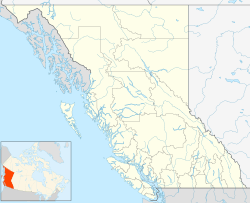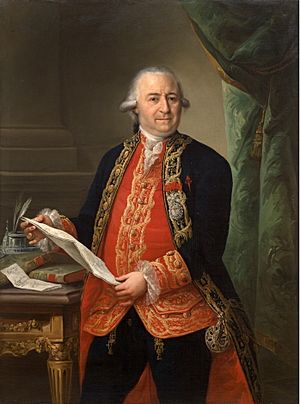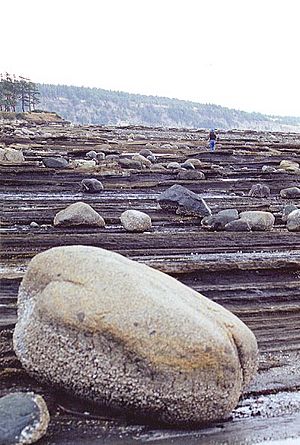Hornby Island facts for kids

Hornby Island as seen from the Hornby-Denman ferry
|
|
| Geography | |
|---|---|
| Location | Salish Sea |
| Coordinates | 49°31′10″N 124°40′0″W / 49.51944°N 124.66667°W |
| Archipelago | Gulf Islands |
| Area | 29.96 km2 (11.57 sq mi) |
| Administration | |
|
Canada
|
|
| Province | British Columbia |
| Regional district | Comox Valley |
| Demographics | |
| Population | 1,225 (2021) |
| Pop. density | 40.9 /km2 (105.9 /sq mi) |
Hornby Island is a beautiful island in British Columbia, Canada. It is one of the two northernmost Gulf Islands, located near Vancouver Island's Comox Valley.
Hornby Island is home to about 1,225 people (as of 2021). Many artists, retired people, small business owners, and young families live here. They all love the peaceful island life. During the summer, the island's population can become four times larger! Many visitors come to enjoy the beaches and nature.
People often visit in spring and fall for hiking, mountain biking, and water activities. Most visitors arrive by ferry from Buckley Bay on Vancouver Island. Some also come by private boats to Ford Cove Marina or Tribune Bay. The closest airport is Comox Valley Airport in Comox.
Popular spots on Hornby Island include Tribune Bay Provincial Park, Helliwell Provincial Park, Ford's Cove, and Whaling Station Bay. The island is also famous for mountain biking. There are many trails in Mount Geoffrey Regional Nature Park, Mount Geoffrey Escarpment Provincial Park, and other areas. About 40% of the island's land, which is about 29.92 square kilometers (11.55 square miles), is parkland.
Contents
Hornby Island's Past and Formation
Hornby Island has a unique history and geology. It was formed after the last ice age, when the land slowly rose up. This process is called post-glacial rebound.
Before European settlers arrived, the island was home to the Pentlatch people. They are a Coast Salish First Nations group. They called the island Ja-dai-aich, which means "The Outer Island."
In 1791, Spanish explorers found the island. The ship Santa Saturnina, led by Juan Carrasco and José María Narváez, named it Isla de Lerena. This name honored Don Pedro López de Lerena, a Spanish Finance Minister. He helped send Spanish ships to the area.
Later, in 1850, the British renamed the island. They called it Hornby Island after Rear Admiral Phipps Hornby. He was a commander of the Pacific Station at that time.
Island Plants and Trees
Hornby Island is mostly covered by thick forests. The most common tree is the Douglas-fir. Other large trees include Western red cedar, western hemlock, grand fir, and lodgepole pine. You can also find smaller Pacific yew trees growing under the larger ones.
The arbutus tree, which has smooth reddish bark, is very common. Other trees with broad leaves include bigleaf maple, red alder, black cottonwood, Pacific flowering dogwood, and cascara. Several types of willow trees also grow here.
At the southern end of the island and in Helliwell Provincial Park, you can find Garry oak trees. Only a small part of the island, about 260 acres (1.05 square kilometers), has very old, untouched forests. About 1,330 acres (5.38 square kilometers) of the island have older second-growth forests.
Amazing Fossils on Hornby Island
Hornby Island is a great place for finding fossils! The rocks here are from the Late Cretaceous period. This means they are very old, from the time of the dinosaurs.
Fossil hunters have discovered ammonite and baculite fossils at Boulder Point. These are ancient sea creatures with spiral or straight shells.
Scientists also found a fossil of a fish called Gwawinapterus on a Hornby Island beach. At first, they thought it was a flying reptile, but later learned it was a type of fish. An actual flying reptile, called an azhdarchoid pterosaur, was also found here.
Another exciting discovery was Maaqwi, an early type of aquatic bird. The island is also known for its many different shark teeth fossils. These show that many kinds of sharks lived in the waters around Hornby Island long ago.
See also
 In Spanish: Isla Hornby para niños
In Spanish: Isla Hornby para niños





